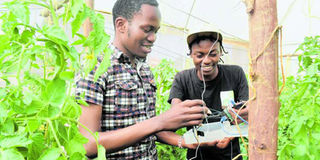New cutting-edge technologies to redefine farming in this decade

In this past photo, Mechatronics Engineering students Denzel Wambura and Muriungi Kithinji, demonstrate the working of their innovation named Nelion Farm System, which digitises greenhouse farming, making it convenient and stress-free. It is encouraging to note that young people are now at the centre of the technological renaissance in farming, with a good number ditching ties and suits for gumboots, a departure from the past. FILE PHOTO | NATION MEDIA GROUP
What you need to know:
- The weather pattern was also not favourable for farmers in 2019, with the rains becoming increasingly unpredictable.
- There were also deepened partnerships between the public and the private sector in transforming agriculture, whose importance cannot be left to government alone.
- The strict rules that will govern the New KPCU and the fund if adhered to are a sure bet to getting the sector’s mojo back.
- Full implementation of these proposals will be music to the ears of smallholder farmers who have largely failed to benefit from government services as middlemen and brokers exploit them.
Agriculture remained the country’s biggest employer last year, absorbing more than half of the working population and contributing the lion’s share to the national purse.
However, the sector continued to grapple with high cost of production, disjointed markets, pests and diseases, paucity of capital and inadequate policy support from government, among other hiccups.
Indeed, it was a tough year for farmers, with many grappling with spiralling cost of general inputs, especially pesticides, whose costs rose following the introduction of a 16 per cent value added tax. The high cost of farm chemicals has opened doors for the proliferation of cheaper counterfeits.
But the bottom-line is that the resulting increase in production costs means that our milk, maize, wheat and eggs cannot compete with those from neighbouring countries.
The weather pattern was also not favourable for farmers in 2019, with the rains becoming increasingly unpredictable.
The ongoing heavy rains in various parts of the country have destroyed tens of thousands of hectares of crops and washed away roads.
The rains followed a prolonged dry spell that equally affected yields, especially for crops planted during the March to May season. This means the country is staring at yet another cycle of food crisis in the coming months.
Despite the grim picture though, 2020 promises to be a much better year for farmers.
To begin with, there has been an increase in innovations and investment in smart agriculture. It is encouraging to note that young people are at the centre of the technological renaissance, with a good number ditching ties and suits for gumboots, a departure from the past.
From intelligent greenhouses, market access apps and livestock tracking technologies, these innovations continue to rubberstamp the nexus between technology and agriculture in growing yields, incomes and economy.
There were also deepened partnerships between the public and the private sector in transforming agriculture, whose importance cannot be left to government alone.
Under President Kenyatta’s Big Four Agenda that among other goals seeks to ensure 100 per cent food and nutritional security for every Kenyan by 2022, numerous enterprises have thrown their weight behind the initiative, which can only mean good fortunes for the sector moving forward.
MUSIC TO THE EARS OF SMALLHOLDER FARMERS
This is the optimism with which we in the agriculture sector step into the New Year, believing this decade promises better fortunes.
The weatherman has warned that climate change will get severe moving forward, which calls for new and innovative approaches in adaptation and mitigation. New-age farming will redefine agriculture as we know it in this decade.
The recent approval by the Cabinet for commercial farming of Bt cotton after years of field trials heralds new opportunities for farmers through increased earnings while growing a crop that is less susceptible to pests and diseases.
It also means Kenya edges closer to its aspirations of being a regional powerhouse in textile and apparel production.
The revival of the giant coffee miller now renamed the New Kenya Planters Cooperative Union, (New KPCU) and the operationalisation of the Coffee Cherry Advance Revolving Fund is great news to the dwindling fortunes of the coffee sub-sector that have seen farmers uproot the once black gold out of frustration.
The strict rules that will govern the New KPCU and the fund if adhered to are a sure bet to getting the sector’s mojo back.
Contained in the Agricultural Sector Transformation and Growth Strategy 2019-2029, there are plans to unlock about 500,000 acres to farming while putting more under sustainable agriculture, connecting one million farmers, pastoralists and fishermen to SMEs that will offer them farm inputs, irrigation systems and post-harvest services.
Full implementation of these proposals will be music to the ears of smallholder farmers who have largely failed to benefit from government services as middlemen and brokers exploit them.
Rewarding farmers under the National Farmers Awards organised by the Ministry of Agriculture in partnership with Elgon Kenya has inspired a new generation of farmers who see value and sense in returning dignity to the soils while creating a farming revolution.
This year promises to be another great one as more farmers continue expressing interest in participating in the awards.
While farmers remain resilient in the face of mounting challenges, the support of key industry players coupled with the committed implementation of the numerous proposals across the value chain will be key in how Kenyan households and economy will benefit from a repositioned agriculture sector in 2020 and beyond.
The writer is the communications Manager at Elgon Kenya.





